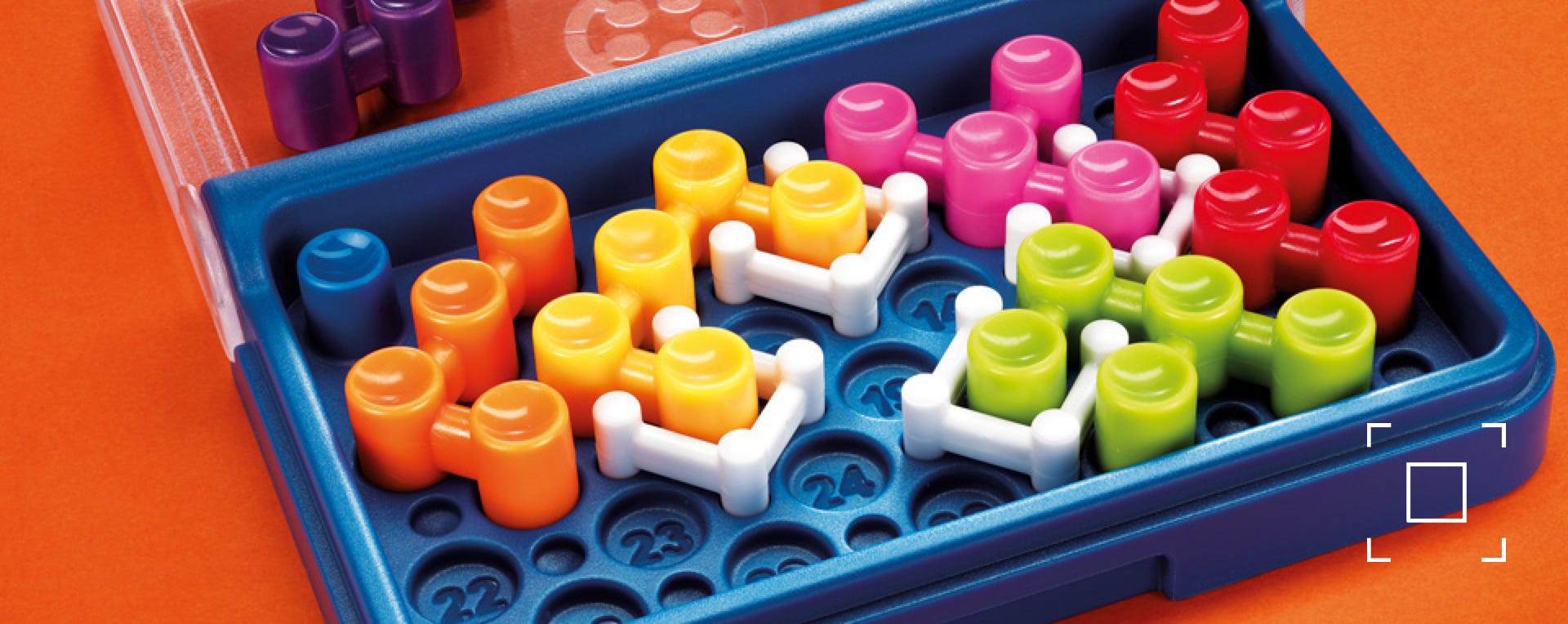
IQ-Blox
The story behind the creation of IQ-Blox
Raf Peeters, January 2015
Another year ... a new game for the popular range of IQ-puzzles. This year I designed IQ-Blocks, already the fifth pocket game for SmartGames.
THINK OUT OF THE B(L)OX
All IQ-puzzles I invented so far include 120 challenges where the main object of the game is to place all puzzle pieces inside a rectangular game board. Each challenge has only 1 solution. To make this possible each game includes a few elements that constrain the number of possible placements of the puzzle pieces. These are the following:
• the size, number and shape of the puzzle pieces
• the size and shape of the game board or grid
On top of these basic constraints there are additional ones that make every game different:
• IQ-Twist: the pegs limit the placement to pieces of the same color that have a hole.
• IQ-Fit: double sided puzzle pieces give much more puzzle combinations, but only the right combination will fit and fill all holes.
• IQ-Link: different puzzle pieces can occupy the same place on the grid, but only in specific combinations (ring and ball) and directions.
• IQ-Steps: the pieces are double layered and need to be placed in a specific order.
In IQ-Blox the additional constraints are 4 little walls. The walls don’t occupy places on the grid, they only occupy the space in between the puzzle pieces. The result is that all challenges start with the same 32 empty places on the grid. IQ-Fit, IQ-Link, IQ-Steps but also games like Back2Back start with a grid where some places are already occupied by puzzle pieces that were given in the challenge. Only the starter-level also shows the position of some colored puzzle pieces, to make this level easier. All other levels only show 4 or less white walls. The setup of each challenge could not be easier or quicker. To avoid any errors during setup, each place on the grid has a clear number, so that you can’t place the walls in the wrong position.
IQ-Blox also has an orthogonal (square) grid like many other of my puzzles (IQ-Twist, IQ-Fit, Quadrillion, Back2Back, etc) but this time the grid is rotated 45°. This makes it a little confusing when you start, because people are not used to this kind of grids. Compared to the other IQ-games I designed, I have the impression that this is one is easier. There are only 7 puzzle pieces and once you start placing them on the game board, you quickly discover if you are on the right track or not. When you solve hard challenges in the other IQ-games, you often don’t know if you are right or wrong until you place the last puzzle piece on the board.

top: example of a Junior challenge (left) and solution (right)

top: example of a Wizard challenge (left) and solution (right)
GAME RULES IQ-BLOX
Set up each challenge by placing the white wall pieces on the game board as indicated in the challenge booklet. Numbers on the game board are highlighted in the challenge to ensure the walls are placed correctly.
1) Easy challenges have 4 walls placed on the board, while more difficult challenges feature fewer walls. The position of the walls cannot be changed.
STARTER challenges also show the position of some of the colored puzzle pieces in order to make the solutions easier to find.
2) Figure out how to place all the colored puzzle pieces on the game board. Colored puzzle pieces can be placed between walls, but cannot overlap the wall parts.
3) You have found the solution when all colored puzzle pieces fit on the game board. You don’t need to use white walls that were not part of the initial setup. There is only one solution per challenge, which can be found at the end of the booklet.
Website ©2024 Raf Peeters
Products and images: © Smart
